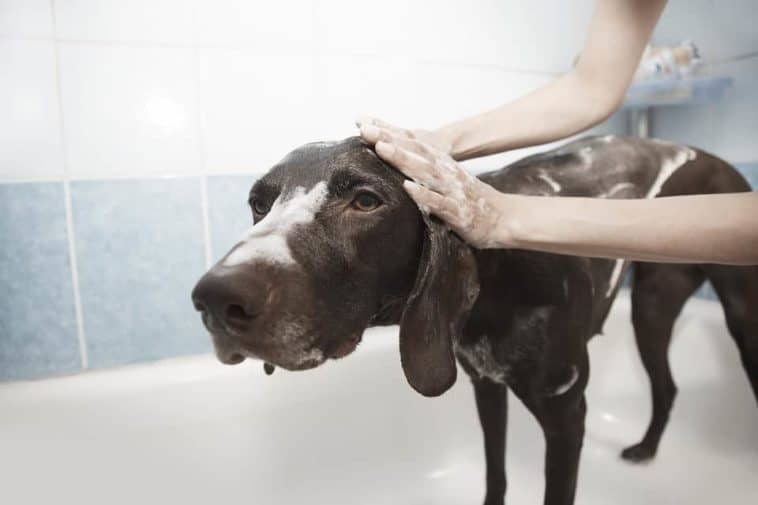As dogs don’t thoroughly groom and clean themselves in the same way that cats do, it’s important to help keep themselves in top condition. Although it may seem pretty daunting, bathing a dog is pretty similar to how we bathe ourselves.
This article will show you how to bathe a dog properly.
Table of Contents
How often should I bathe my dog?
The amount of times you bath your dog every month or year depends on your dog’s size, breed, fur length and thickness, lifestyle factors, activity levels, and types of activity they undertake.
Dogs that spend most of their time outdoors, will likely need more frequent bathing than those that spend most of their day indoors.
It’s important not to bath your dog too often as it can cause skin irritation, especially if their skin isn’t dried properly or if scented soaps are used. You should factor in the following before deciding whether to bath your dog:
- How strong they smell
- The level of dirt encrusted in their coat
- If they suffer from any skin conditions
- Allergies that your pet has
- The thickness of their fur
If your dog’s odor doesn’t bother you, and their lack of bathing doesn’t lead to health issues; then there is no imminent need for you to bath your dog.
If your dog has a skin condition or suffers from allergies, then a vet may prescribe a specific amount of times they are to be bathed, to combat or not contribute to the worsening of their skin condition.
How to bathe a dog: Top tips for bath time
Step 1: Select an appropriate and contained area for bath time. Shower cubicles, bath tubs, wet rooms, a large bucket, or even a baby bath could all be used. Just make sure your dog has enough room to stand comfortably in it. If you are not using a shower head, then use a jug and bucket to rinse your pup.
Step 2:Make sure you have all products and plenty of old towels within arm’s reach before you begin. If you don’t want to get too wet yourself, wear a rain jacket or other waterproof.
Step 3:Thoroughly brush your dog’s coat first with a soft, wide bristled brush.
Step 4:Only use dog shampoo as even gentle human shampoo can cause irritation and lesions on the delicate skin and hair follicles of a dog, and make sure you wash any soap or shampoo off your dog thoroughly. Consider using a coat conditioner, especially if your dog is prone to dry skin.
Step 5:Dry your dog thoroughly and don’t let them go outside until they are completely dry.
How should I wash my dog?
Ensure you test the water temperature before you begin. As a dog’s skin is very sensitive, what may feel warm on your skin, could be too hot for a dog.
Run it against the inside of your wrist, like when testing the temperature of baby milk. You are looking for a gentle, lukewarm temperature. If the water is too cold, its likely your dog will feel uncomfortable and attempt to escape!
Once your dog is in the bath, wet them thoroughly, massaging their fur to ensure they are completely wet. Begin by shampooing their hind legs and backside.
Then shampoo their body, followed by their front legs. Finally, end by washing their head.
Be careful to avoid getting shampoo in their ears, eyes and mouth. Then rinse them twice to ensure that all suds are removed.
Some dog owners like to use a dog conditioner; however, this is entirely optional and will be sometimes helpful for longer coated breeds of dogs that are prone to getting knots.
Drying your dog
Before you begin bathing your dog, put a heating source on, so that when they get out of the bath, it will be nice and warm, which will help them to dry more easily.
Once bath time is over, allow your dog to shake off their fur behind a shower curtain or bath screen.
Then, bring your dog out of the shower and make them stand on a towel or an absorbent bath mat.
Next, wrap a towel over the back of your dog and rub them down in the direction of their fur growth; front to back. Make sure you also dry their inner legs, tail, and stomach too.
Finally, give your dog a good brushing down, paying attention to any knots left behind from the bath. Dogs love to chew on these if they aren’t brushed out properly, so run your fingers through their fur to find them.

